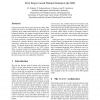Free Online Productivity Tools
i2Speak
i2Symbol
i2OCR
iTex2Img
iWeb2Print
iWeb2Shot
i2Type
iPdf2Split
iPdf2Merge
i2Bopomofo
i2Arabic
i2Style
i2Image
i2PDF
iLatex2Rtf
Sci2ools
90
Voted
AROBOTS
2007
2007
First steps toward natural human-like HRI
Natural human-like human-robot interaction (NHL-HRI) requires the robot to be skilled both at recognizing and producing many subtle human behaviors, often taken for granted by humans. We suggest a rough division of these requirements for NHL-HRI into three classes of properties: (1) social behaviors, (2) goal-oriented cognition, and (3) robust intelligence, and present the novel DIARC architecture for complex affective robots for human-robot interaction, which aims to meet some of those requirements. We briefly describe the functional properties of DIARC and its implementation in our ADE system. Then we report results from human subject evaluations in the laboratory as well as our experiences with the robot running ADE at the 2005 AAAI Robot Competition in the Open Interaction Event and Robot Exhibition.
Related Content
| Added | 08 Dec 2010 |
| Updated | 08 Dec 2010 |
| Type | Journal |
| Year | 2007 |
| Where | AROBOTS |
| Authors | Matthias Scheutz, Paul W. Schermerhorn, James F. Kramer, David Anderson |
Comments (0)

